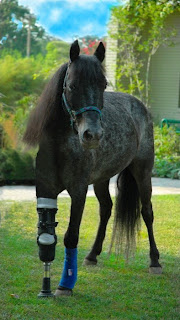Charlie, which way to Candy Mountain? PONY PROSTHESIS!
Anyone who gets the obscure title (besides Burt or Sarah) gets an airkiss from me.
Our department chair sent us an e-mail with the following story and it's like, the most awesome story in the entire world. I've received lots of awesome stories this weekend!!! And it took away the sting of the poor euthanized Kentucky Derby pony 🙁
I've written articles over the years about horses who survived amputation surgery. There was Boitron, the California Thoroughbred stallion who could service mares after amputation surgery. There were Dr. Ric Redden's dramatic cases of founder survivors who galloped around his paddock on artificial feet with “transplanted frogs”. Dr. Chris Colles had the never-say-die Appaloosa in England with the spring-loaded foot. And who can forget that paint yearling in India ? Or the landmine-maimed elephant amputee in Thailand ? Longtime Hoofcare and Lameness Journal readers will remember them all.
So when I first heard that a pony had survived amputation surgery at Louisiana State University 's (LSU) equine hospital, I didn't run to the keyboard and beg for photos. A few weeks later I did, though.
Meet Molly. She's a gray speckled pony wh o was abandoned by her owners when Katrina hit southern Louisiana . She spent weeks on her own before finally being rescued and taken to a farm where abandoned animals were stockpiled. While there, she was attacked by a pit bull terrier, and almost died. Her gnawed right front leg became infected and her vet went to LSU for help. But LSU was overwhelmed, and this pony was a welfare case. You know how that goes.
But after surgeon Rustin Moore met Molly, he changed his mind. He saw how the pony was careful to lie down on different sides so she didn't seem to get sores, and how she allowed people to handle her. She protected her injured leg. She constantly shifted her weight, and didn't overload her good leg. She was a smart pony with a serious survival ethic.
Moore agreed to remove her leg below the knee and a temporary artificial limb was built. Molly walked out of the clinic and her story really begins there.
“This was the right horse and the right owner,” Moor e insists. “Molly happened to be a one-in-a-million patient. She's tough as nails, but sweet, and she was willing to cope with pain. She made it obvious she understood (that) she was in trouble.” The other important factor, according to Moore , is having a truly committed and compliant owner who is dedicated to providing the daily care required over the lifetime of the horse.
Molly's story turns into a parable for life in post-Katrina Louisiana . The little pony gained weight, her mane felt a comb. A human prosthesis designer built her a leg.
“The prosthetic has given Molly a whole new life,” Allison Barca DVM, Molly's regular vet, reports. “And she asks for it! She will put her little limb out, and come to you and let you know that she wants you to put it on. Sometimes she wants you to take it off too.” And sometimes, Molly gets away from Barca. “It can be pretty bad when you can't catch a three-legged horse,” she laughs.
Most important of all, Molly has a job now. Kay, the rescue farm owner, started taking Molly to shelters, hospitals, nursing homes, rehabilitation centers. Anywhere she thought that people needed hope. Wherever Molly went, she showed people her pluck. She inspired people. And she had a good time doing it.
“It's obvious to me that Molly had a bigger role to play in life,” Moore said, “She survived the hurricane, she survived a horrible injury, and now she is giving hope to others.”
“She's not back to normal,” Barca concluded. “She's going to be better. To me, she could be a symbol for New Orleans itself.”
This week, Molly the Pony, a children's book about the pony who has already inspired thousands of people around New Orleans , has been published.
It's not a book about amputation or prosthetics, it's a book about people and ponies. But the photos you see here are from the book.
Maybe Molly won't make the vet textbooks, but she might reach more people from the pages of this book for children. If you know a child, a library, a hospital, or maybe a therapeutic riding program that can use a lift, here's a book that can do that. And you can explain how the leg and hoof work!


